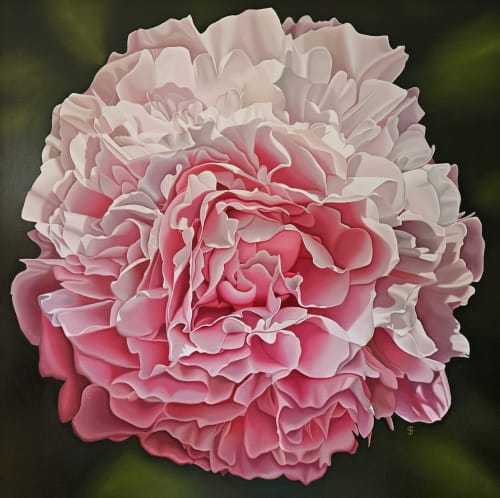Experience the sustainable studio ethics of Wiltshire’s Steve Foster, as he captures the fleeting beauty of nature—highlighting delicate, transient moments while embracing eco-conscious practices.
Fifty-five-year-old fine artist Steve Foster has spent the past six years crafting evocative Light and Form oil paintings that explore the intrinsic connection between nature and the human life cycle, all within his Wiltshire studio. The interplay of reflection and shadow in Foster’s subjects holds the gaze of viewers—first inviting them to notice, then urging them to understand.
Works such as Raspberry Ripple and Into the Light prompt quiet, contemplative dialogues about fragility, beauty, and the simplicity of life. Amidst their rich, saturated depth, they offer a moment of stillness—a gentle pause to reflect on our role as witnesses to the world around us.
A sports enthusiast and devoted father of one, Foster sees art as a conduit for feeling. “Making people feel something” is, for him, the entire point. And that emotional connection doesn’t end with the final brushstroke. Foster believes interaction is fundamental to the creative process—from conception through to exhibition. For him, the conversation around sustainability begins at the very first stages of making, and continues in galleries, where ideas are exchanged between buyers and viewers alike.
Much like Gallery Les Bois, Foster hopes these dialogues will increasingly centre on the possibilities of a sustainable future within the craft that defines him.
“Art is about making people feel something,” Foster reiterates. “Of course, we can all admire a piece and appreciate its colour and style—but what makes it compelling? I want people to ask themselves, ‘Do I find this compelling?’”
With his integration of sustainable practices, we at Magazine Les Bois would argue there’s more than meets the eye in Foster’s ever-evolving body of work.
Foster’s ability to render Earth’s delicate, vanishing beauty underscores the intimate harmony between nature and humanity. Just as a flower blossoms and peaks—a fleeting moment of ephemeral wonder—so too does his work preserve the quiet poetry of the passing moment, captured in shimmering layers of oil.
And much like the beauty of our planet, which so many of us long to protect, our reverence for nature should be mirrored in how we choose to immortalise it.
Inspired by British cyclist Dave Brailsford’s now-famous marginal gains philosophy—which suggests that consistent 1% improvements in multiple areas can lead to profound transformation—Foster implements daily, intentional shifts in his studio practice.
“Do what you can [to be sustainable].” — Steve Foster
This mindset reflects a grounded, incremental approach to the broader challenge of environmental responsibility. For Foster, sustainability is more than a theme—it’s a structure through which artistic excellence and ecological mindfulness converge.
Sustainability in Action: Small Changes, Big Impact
One of Foster’s most pragmatic yet powerful commitments is simply reducing the volume of materials he purchases. While the temptation to indulge in new oils or brushes is ever-present, he chooses restraint, acquiring only what he truly needs.
By avoiding overconsumption, he sends a clear signal to suppliers: sustainability is no longer a fringe concern in the art world, but a growing priority.
“It’s the little changes we make individually that, over time, shape broader shifts in artistic communities,” Foster notes. “This could encourage commercial companies and galleries to adopt more eco-conscious models.”
As consumer values evolve, he hopes craft retailers will follow suit—decreasing overproduction and improving the sustainability of their offerings.
The Two Pillars of Sustainability in Art
Foster distills his eco-ethos into two guiding principles:
• What you buy
• How you use what you have
A small but consistent act: he thoroughly cleans his palettes and brushes after every studio session. It’s a simple discipline, but one that prevents waste and cultivates an appreciation for craftsmanship. It also serves a symbolic role—an intentional close to the creative day, merging thought with habit.
By centring these practices, Foster embeds sustainability not as a gimmick or afterthought, but as a foundational part of his process. In doing so, he models a quiet but potent transformation in the role of the contemporary artist.
The Bigger Picture: Beyond the Canvas
“Flowers are a world of their own,” Foster reflects.
Just as a single bloom holds an entire ecosystem of beauty within it, so too must the practice of sustainability be woven into the heart of artistic creation—a reminder of life’s fragile rhythms, and of our own responsibility to protect them.
“We have to allow the conditions for that beauty to be in place,” he continues. And indeed, we must.
To capture time—to freeze a fleeting moment in pigment or oil—is one of art’s great powers. But to extend the life of beauty through mindful practice? That, perhaps, is an even greater triumph. It’s the act of ‘holding time’ not only through material but through mindset—shaping not only what we create, but who we become.
As demand grows for sustainable work, Foster remains hopeful: that buyers will increasingly seek out consciously made art, and that emerging artists will explore what role they, too, can play in building a more sustainable creative future.
